
50 Email Sign-Offs for Different Contexts That Generate Replies
Email sign-offs might seem trivial to many, but are they? While it’s important to compose a well-crafted email body, the way you close an email is equally valuable if you want to create a positive impression, especially in business.
Does “best regards” sound out of date? Is a simple “thank you” too simple? Learn why email sign-offs make a world of difference and how you can use them to increase your response rates in various contexts.
What Is an Email Sign-off?
The email sign-off is the way email senders end an email, and it usually consists of one phrase followed by the sender’s name. It’s the last impression you leave readers with, which can be as strong as the first, like a farewell or a final handshake to seal a deal.
While “Kind regards” is a safe sign-off, many senders choose more creative alternatives to stand out, like the closing in the welcome email example below:
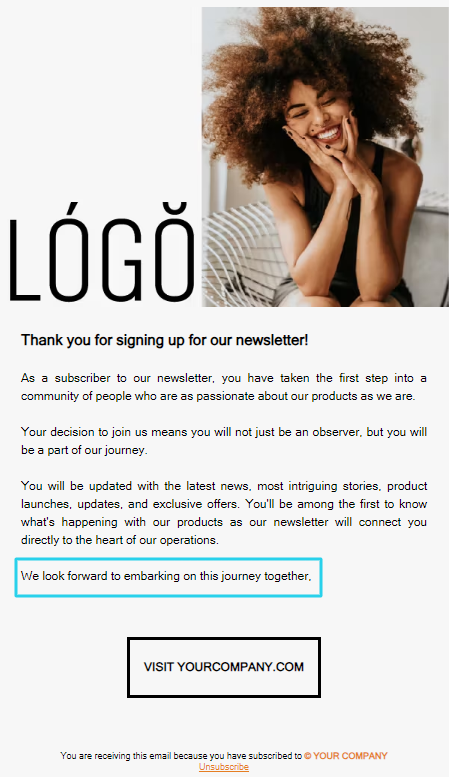
Email sign-off vs. email signature
Some people confuse the sign-off with the email signature, but they’re not the same. The signature is a block of text placed at the very end of emails–underneath the sign-off–including key details about the sender, such as full name, phone number, or business logo. It helps the reader identify the sender and contact them easily.

Why Your Email Sign-Off Matters
The way you sign off your email has an impact on your email recipients, whether you want them to take a specific action, such as sharing information or booking an appointment, or just build good rapport.
According to a study of over 350.000 email threads, not only does a sign-off at the end of your email improve the overall average response rate, but using one that implies a sense of gratitude significantly boosts the chances that someone will write back.
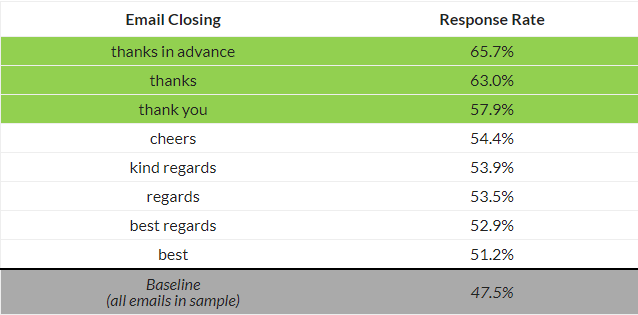
No matter what you choose, remember that an email sign-off is the last thing recipients read and determines how quickly they will respond–or whether they will respond at all.
Do you feel insecure about your email copywriting or want to automate a part of your email creation tasks to save time without compromising quality?
Moosend offers an AI writer to help you produce content based on email type and tone of voice, among other factors, to stun your audience.
Email Sign-Off Types and Examples
With email being one of the primary communication tools today, there are many different messages that you send during the day, ranging from formal to stakeholders to friendlier ones to coworkers.
Let’s see some popular examples for each category. You can also copy this doc and pick the ones that suit your email communication style based on the context each time:
1. Formal business email sign-offs
Let’s kick off with common professional email sign-offs:
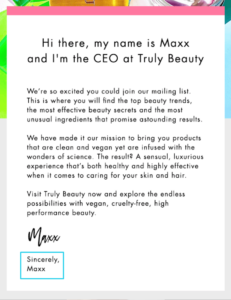
Source: Truly Beauty
- [Yours] Sincerely: A classic closing, perfect for a professional email. It might sound too formal though, for businesses like startups and agencies.
- Best regards: A safe choice when you want to sound friendly toward someone you don’t know well.
- Warm regards: Another polite way to end your email when a warmer tone is needed.
- Best wishes: A great formal way to end your email with just the perfect touch of friendliness.
- Respectfully: Very formal and even a little stiff, but a standard way to close a business email, especially if the recipient is in a leadership role.
- Yours faithfully: Popular among students, suitable for cases when you either don’t know the exact name of the recipient and start with “Dear Sir/Madam.”
- Cordially: This one adds an extra touch of formality, so keep it for special occasions that demand sincerity.
Pro tip: Abbreviations like “Rgrds” and fun puns don’t fit in this category. It’s best to keep them for less professional settings or contexts that allow for more creativity.
2. Appreciative email sign-offs
Do you want to express gratitude to your readers? Here’s how to do it:
- Thanks in advance: Gratitude plus expectations equals higher response rates. However, thanking someone in advance may come across as demanding, so use it wisely.
- Thank you/Thanks: A simple thank you is genuinely grateful and can convey a tone of expectancy. Adding an exclamation point makes your email sign-off sound more natural and enthusiastic.
- I appreciate your (help, input, feedback, etc.): Use it when you want to emphasize your appreciation for something the reader has done for you.
- Thank you for taking the time to [what they did for you]: Showing someone that you appreciate their time and help goes a long way.
- Thanks for the consideration: Looking for a way to tell your reader that you appreciate their interest in your product or service? That’s the one.
- Much appreciated: An alternative way to express your genuine appreciation for something the recipient has done.
Pro tip: One sincere and wholehearted thanks is enough to show your readers how you feel. There’s no need to flood them with words of gratitude in the email body, as well, otherwise you might sound cheesy or unconfident.
3. Casual email sign-offs
Do you want to sound less formal to your readers? Here’s how:
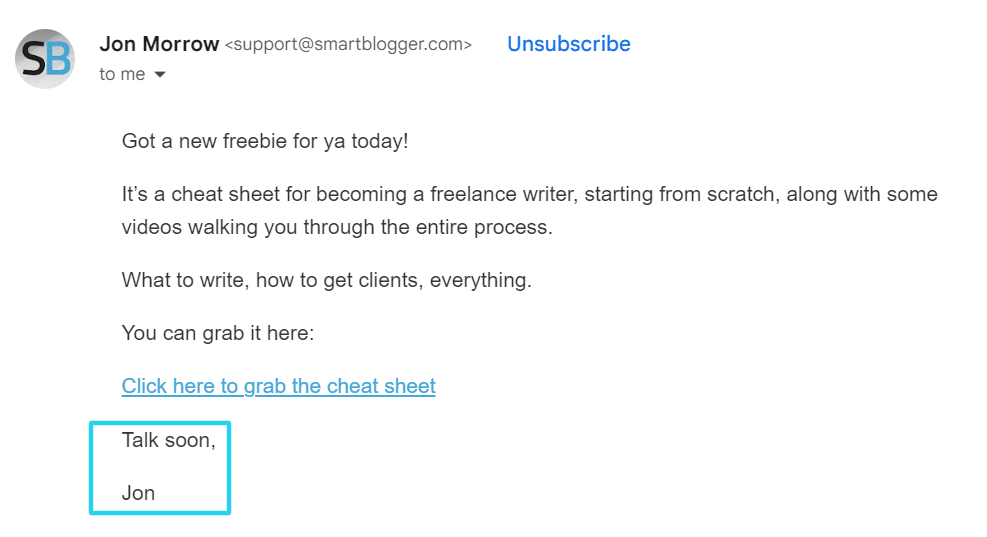
Source: SmartBlogger
- Talk soon: Short and informal, suitable when contacting colleagues, close partners, or frequent customers.
- Best: One of the most common email closings, friendly and cheerful at the same time. However, if you want to give your email closing a more dynamic and attention-grabbing tone, choose an alternative.
- All the best: Suitable for both professional and more informal emails, and perfect for business messages with a relaxed tone.
- As ever: If you’re writing an email to a coworker or long-term business partner, then this is a great sign-off for you.
- Cheers: Some people dislike this one, but maybe you can pull it off. It’s got a cheerful vibe that fits well in emails to people you know well, but it can seem a bit pretentious if you’re not British or Australian.
- Until next time: Suitable for consistent communications with colleagues, partners or even customers that don’t demand formality.
- Can you let me know? Ask for feedback from close contacts without wasting time.
Pro tip: When drafting an email, it’s important to take cultural differences into consideration. For instance, “Ciao,” and “Have a good one” may not make sense to people in certain countries, so it’s best to revisit them.
4. Kind email sign-offs
Do you want to add a warmer and personal tone to your email sign-offs? Here are some ways to do it:
- Hope this helps: If you’re sending an email with specific information, then this is a great sign-off for you.
- Have a good [day/month/one]: It’s a semi-formal email sign-off that will put a smile on your reader’s face.
- Take care: An excellent informal way to end an email, regardless of the circumstances. It’s friendly, conversational, and great for people you actually know.
- To an amazing (time/week/weekend/rest of the week): Positive and feel-good, this email sign-off is great to cheer your readers up.
- Hope your week’s off to a good start: Make your recipient’s Monday a little better with a friendly, joyful sign-off.
- Good luck: Send good vibes to readers who’re about to hit a milestone or complete a challenging task to support them.
- Happy holidays: If holidays are around the corner, remember to send your best wishes to recipients.
Pro tip: If you’re thinking about adding “Yours truly” at the end of your message, maybe reconsider it, as it sounds far-fetched in professional settings.
5. Friendly email sign-offs
Are you looking for friendlier email closings to send to readers you feel closer to? There you go:

Source: Tattly
- Waving from [location]: A great option for global businesses who communicate with people in different countries.
- Looking forward to chatting more about this: Share your availability for further communication and add an enthusiastic tone.
- Let me know how things go: If you want to make the recipient answer back, then maybe you should create the right chance with a similar sign-off.
- Don’t hesitate to get in touch if you have any questions: Pitching an article, an idea, anything? Let your readers know you are open to questions and make them feel more comfortable.
- Thanks for reading this email. Here’s a picture of a kitten: Reward your readers and make them smile. Super combo.
- One step closer to Friday: Let’s admit it. Friday is what we all wait for the whole week. Cheer your readers up by reminding them the weekend is close.
- Congrats on reading this whole email: Lengthy email? Your receiver deserves some recognition.
- Let me know if you want to chat about this over coffee: This email sign-off is warm and friendly, while also making a kind suggestion.
Pro tip: Well, this tip might sound obvious, but sounding friendlier than you should, might restrain readers from replying to you in several professional setups, such as Law or Government organizations. So, think twice before hitting the send button.
6. Complimentary email sign-offs
Time to go the extra mile with a few compliments:
- Stay awesome: Charm your reader with some kind words and they will probably feel obliged to follow up.
- Great working with you: If you’re sending an email to someone you worked with, let them know you enjoyed collaborating with them. This way you keep the door open for reunions.
- Keep up the good work: Happy for someone’s work? Give them a pat on the back with an encouraging email sign-off with just the right mix of flattery.
- You’re an inspiration: Save it for someone that has done something inspiring or helped you look at things differently.
- Congratulations/Congrats: A great booster for your readers in the shape of an email sign-off.
Pro tip: Does “xoxo” sit in this category? Probably not, except if you can guarantee that email etiquette allows it.
7. Unique email sign-offs
In search of a creative and witty email sign-off? Here are some suggestions from pop culture and beyond:
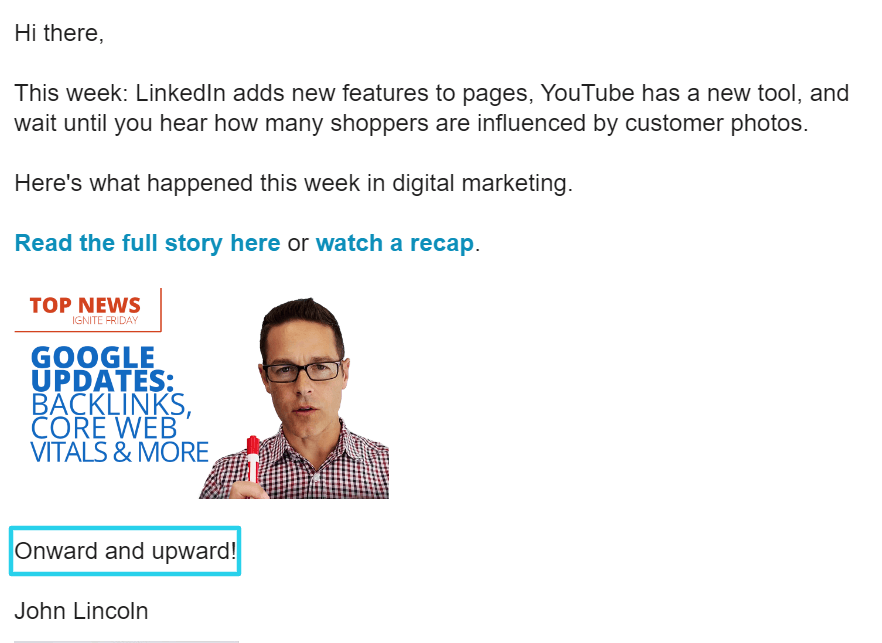
Source: Ignite Visibility
- Onward and upward: Use this well-known quote to motivate your subscribers and get them going.
- Live long and prosper: You probably saw that coming, but who doesn’t recognize this Star Trek line? A great option for the geeky business world (you know who you are).
- I’ll be there for you: This is for Friends fans wishing to build rapport with their audience.
- It is never too late to be what you might have been: This quote by George Eliot is excellent for those who want to inspire their audience.
- To infinity and beyond: This Toy Story quote hits us straight at heart and can turn into a motivational line for your readers.
Pro tip: If you adopt a similar tone to your messaging, you can also add a relevant emoji to spice things up a little more.
8. Funny email sign-offs
If you want to share a good laugh with your readers, check out these options:
- Virtually yours: Suitable for remote workplaces and friendlier email communications.
- See you later, alligator: Another movie line you can share with coworkers and friends.
- Hope your Monday’s full of coffee: We’ve all been there, so let’s unite.
- Don’t worry, be happy, and reply to this email: If you want a reply but hate sounding forceful, here’s a funny alternative for you.
- Keep calm and send lots of memes: In case of emergency, here’s a line to soothe your readers.
Pro tip: Not everyone shares the same sense of humor, so know your audience first, and then end your email messages with a plot twist.
Email Sign-Off Best Practices
When composing your email sign-off, there are a few things to keep in mind:
Think of the context
Not all emails are the same. Keep your readers and the email goal in your mind when writing your sign-offs. And remember, adjusting the tone you use in your closing is as important as the tone you use in the rest of your email.
Connect with the readers
Your email sign-off is your last resort to stick to your readers’ heads. Think of how you’d like to wave goodbye to them based on the relationship you have and how you’d like it to be in the future.
Combine it with your email signature
We’ve talked about email sign-offs and yes, it’s not the only thing that matters in your email ending. Your email signature brings value, too. Here’s what you should include to help readers understand who they’re talking to and reach out to you the way that suits them:
- Your full name
- Your professional title
- Contact information
- Social media
Create a subtle call-to-action
Plus, if you don’t know how to end an email, it’s helpful to visualize what you’d like the recipient to do once they finish your email. Do you want them to book a meeting, turn on the coffee machine and get to work, or simply smile? Then, the stage is yours.
End Your Email Like a Pro
Long story short, shaping your email sign-off carefully is not a waste of time. It leaves an impression on whoever receives your email and even motivates them to act. Follow the above suggestions wisely and remember that different emails call for different email sign-offs.
Looking for a stellar email marketi platform to streamline your email marketing efforts successfully, including AI writing capabilities? Sign up for a free Moosend account and get started asap.
Over and out!
Email Sign-Off FAQs
Before we wave you goodbye for good, let’s explore some frequently asked questions about our topic:
1. What is the best email sign-off for an email?
It depends on the context and the reader; “Kind regards,” “Best wishes,” and “Thank you” are among the best options for different purposes.
2. How do you end an email politely?
Use email sign-offs like “Feel free to ask any questions,” “Have a great day,” and “Take care.”
3. How should emails be signed off?
You can use phrases such as: “Yours sincerely,” “Best wishes,” “Thanks in advance,” and “Hope this helps” based on the context and goal of the email.
4. How do you sign off a professional email?
The most common formal email sign-offs are: “Best regards,” “Yours sincerely,” “Respectfully,” and “Thanks for the consideration.”
5. What are the worst email sign-offs?
Abbreviations such as “Thx,” “Rgrds,” and “xoxo,” the “Sent from my iPhone” note and no closing at all usually disappoint readers–including typos.




 Published by
Published by


 Published by
Published by
Great article. However, I want to know how to create that Zest-like info block on my emails. How do I do that?
Thanks!